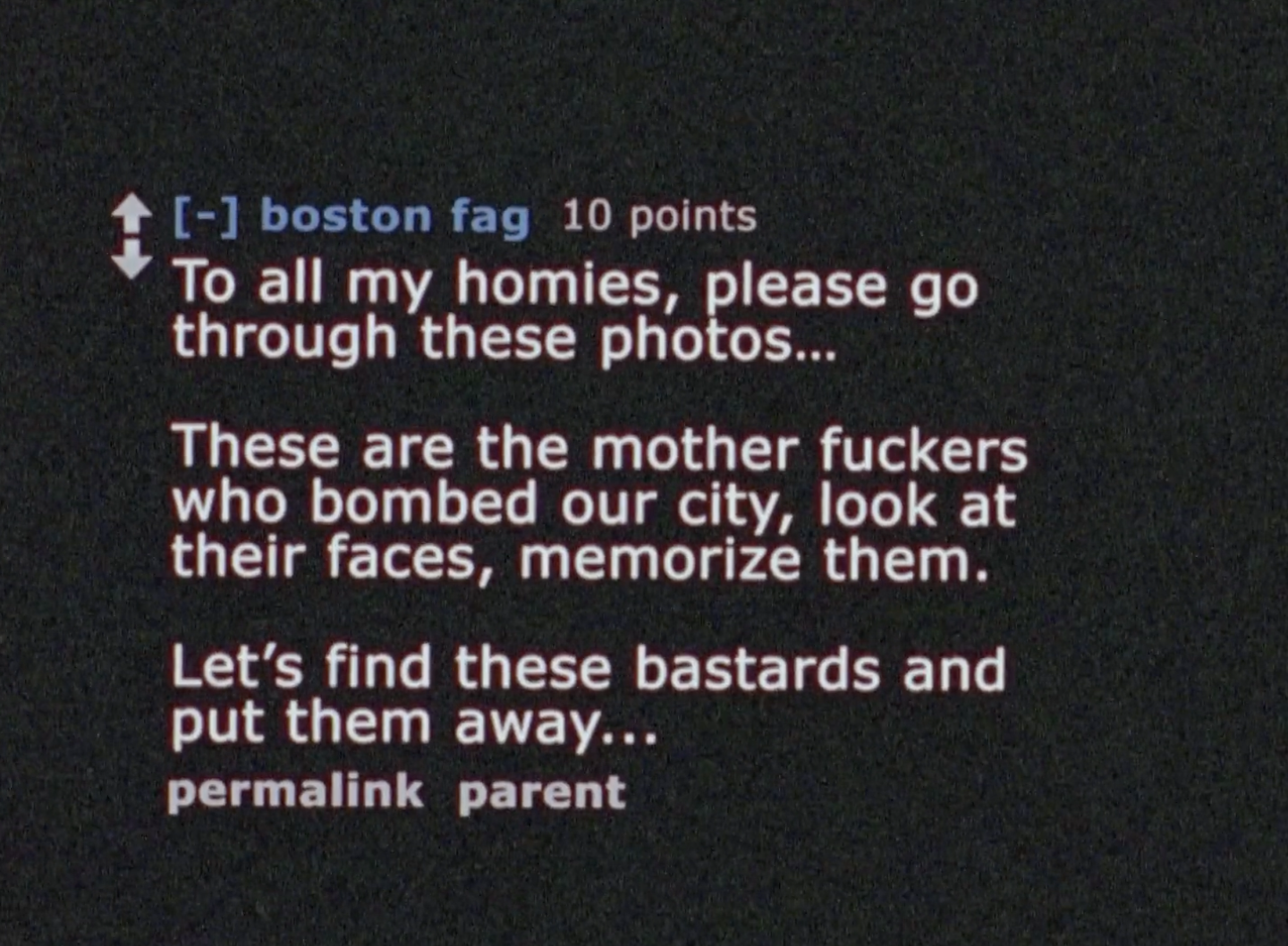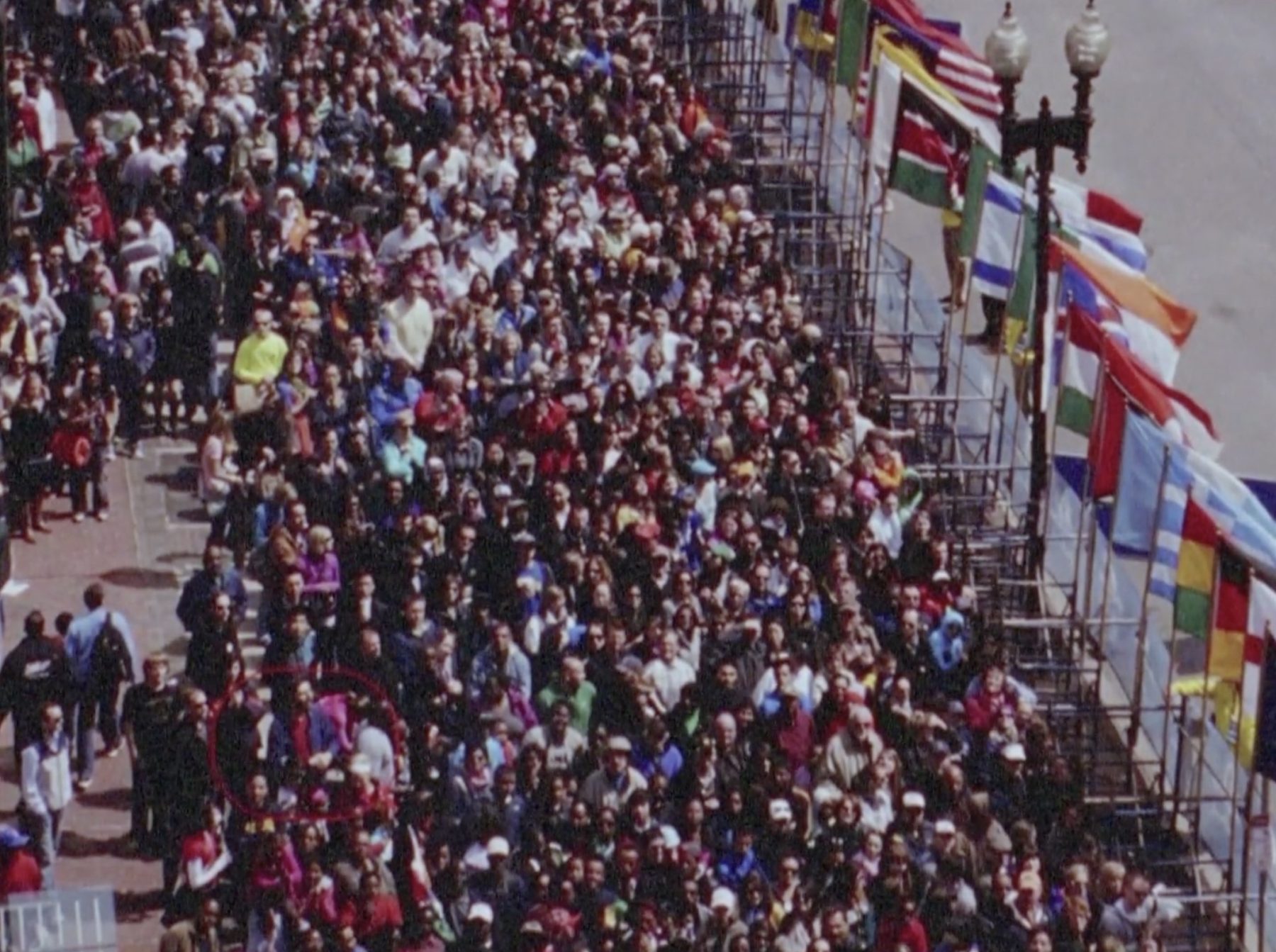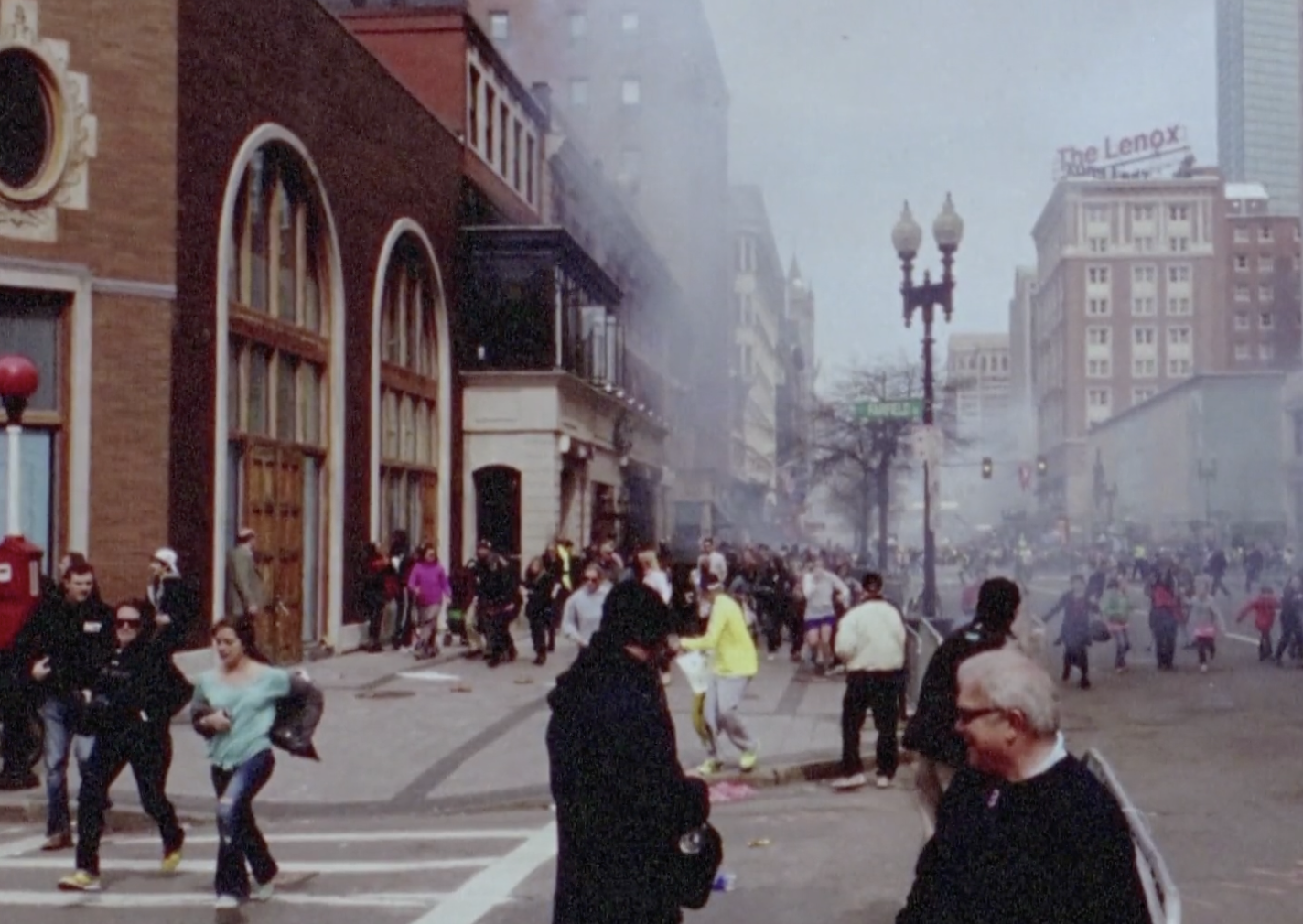On Watching The Detectives
July 30, 2022
On April 15, 2013, two homemade bombs using explosive packed pressure cookers were detonated on Boylston Street, near the finish line of the Boston Marathon. The explosion killed three and injured over two hundred other bystanders, setting off a firestorm of attention. As law enforcement performed their usual investigations into the event, an online forum or “subreddit” called r/findbostonbombers quickly appeared on Reddit to try and crowdsource clues to help identify the bombers. Participants worked with a set of amateur photographs that had quickly appeared online, these had been collected from witnesses who had uploaded their images to the internet. Redditors combed through this material to see what they could discover.
The Reddit thread itself became a bit of a sensation, as media used it as both source material and cautionary tale. Three days after the bombing, the FBI released images of their suspects and the Reddit thread pivoted to attempting to figure out where they might be. Shortly after the FBI released their images the suspects—two brothers—were seen in public and subsequently led the police on a manhunt through the Boston suburb of Watertown. The manhunt led to the death of one suspect, the older brother Tamerlan Tsarnaev. His younger brother Dzhokhar Tsarnaev was apprehended and remains on death row.
I became aware of the /findbostonbombers subreddit soon after the bombing occurred and, after a day or two of following the threads, I began to make a film with the subreddit conversation. The result, Watching the Detectives (2017), is a 37-minute silent 16mm film. It utilizes the images that were uploaded to the thread and edits the Reddit posts into silent film intertitles. When watching the film, the audience reads along with Redditor attempts to find the suspects behind the bombing. The film is both a document of these Reddit threads (more relevant now that they have almost disappeared into historical oblivion) and casts a critical eye at the process of creating meaning from images on the internet.

I have long had the sense that film is a medium for measuring and organizing space, largely through one of its main elements—the frame. The frame separates what the camera focuses on from the rest of the environment that is outside of that frame. What we see in a film, what the filmmaker allows us to see, is decontextualized from its environment. What is framed in a film is then interpreted by the viewer, who brings their own personal context to bear, recontextualizing the image through their own experience.
One of my earlier films, Tamalpais (2008), tried to visualize this observation. It is composed of three sets of 35 shots, each one created by shooting sequentially through an Albrecht Dürer-inspired “veil of threads”. The viewer watches the sequence without explanation, until a wide shot introduces the framing device and then the viewer re-watches the sequence, this time with a more complete understanding. The viewer is invited to reconstruct what the landscape looks like based on the images they are presented with. It requires some imaginative power to connect the shots together to create the full tableau in the mind’s eye.

At first blush, the minimalism of Tamalpais may seem quite different from Watching the Detectives, but I see a similar structure to the found images that form the core to the newer film. Watching the Detectives is composed solely from images and text harvested from the /findbostonbombers subreddit. The subreddit was reliant on images that were supplied by eyewitness photographers who had been at the scene of the bombing. As such, the Redditors had a limited cache of amateur photographs to work with, they were completely dependent on what was uploaded to Reddit and 4chan. Despite this, the Redditors made the assumption that these images contained the truth they were looking for, the reality was that most of the data necessary for a successful investigation existed outside the frame of these photographs.
I was struck by the flatness of the images that were collected, a flatness that was emphasized by Redditors drawing on the images digitally to emphasize certain details. With these lines and circles, crudely executed in programs like MS Paint, the Redditors intervened in the images—flattening their depth to persuade us towards their interpretation. The drawn interventions became an overlay, framing space and directing the viewer in a certain direction.

An iconic moment for me in this collection of photographs is a wide shot. It was photographed from an office window above the crowd, which squeezed many of the major players from the Reddit drama into the frame. A collection of a thousand faces was captured within the minutes prior to the Boston bombing and provided a cast of characters for the Redditor to parse. Eventual suspects in the Reddit threads—Blue Robe Guy, two runners who were late to the race, a trio of bystanders who may or may not have been friends— all were captured in this photograph—everyone within the scene flattened by the lens of the camera into a two-dimensional cut-out, tempting the Redditor to encircle them in an attempt to give their narrative fuller shape.

Reading the many text-based threads on r/findbostonbombers was an exercise in following the construction of meaning. The found set of images were interpreted by dozens of Redditors bringing in their personal contextual understanding, reading the images with their own individual understanding. The Redditors had no real tools with which to address their investigations—only assumptions. Occasionally a Boston Redditor could provide local colour to the conversation, as when one Redditor exonerated the street preacher who he recognized from Fenway Park. Otherwise, the Redditors were operating on the past conditional – what might have been. There is here the possibility of an incessant unfolding of internet searches, leading to endless conclusions—a frame surrounded by serpentine paths.
A typical thread would focus in on a person in the crowd and wonder why they were there. If they had backpacks in the earlier shots, Redditors would try and find them again with no backpacks in photographs culled from the aftermath. Some characters became more compelling because of a certain detail that set them apart from others and allowed embellishment. These compelling details often focused upon assumed ethnicities. Each thread functioned as a narrative, unfolding believably enough until someone challenged it with another observation—a conflicting photo that disproved the narrative or, occasionally, a statement from someone who was present in the crowd (in 2013, witnessing an event in person still carried some weight). Thus, each thread had a narrative trajectory to it that often ground to a quick halt, unless someone offered a counter-argument and decided to continue the path.

In the process of creating the film, I had to work through dozens of threads of discussions, each focusing on a particular person in the crowd or a certain detail that caught people’s attention. These threads happened in a condensed period of time and focused on a condensed space of a few city blocks—so I edited with a sense of simultaneity and proximity. Although I was working only with text and still images, I edited as if I was cross-cutting between scenes— cycling between the different storylines developed by the Redditors to turn bystanders into suspects. In traditional editing, crosscutting is a way of defining two filmic spaces in relationship to each other and within this film it introduced a similar enlargement, creating an expanded conceptualization of space for the viewer. Crosscutting is an effective tool for narrative propulsion, so it was an apt way to enhance the micronarratives drawn from the various Reddit threads. It held the various visual and textual threads in balanced equilibrium, stimulating the imagination of the viewer to weave them together into their own cohesive reading.

When balancing the image world with our understanding of this event, it is useful to reflect on the relationship of the Reddit thread to the city space . Most of the images were gathered from a very small area of Boston, in the area around Boylston Street where the bombing took place. Many of the shots that Redditors found useful were photographed from a high angle, an aerial viewpoint of the crowd below, gathered by people watching from the higher levels of the buildings that flanked the finish line of the Marathon. Freed from the constant movement of the street-level crowd, these images have the illusion of providing an overview; they function in similar ways to surveillance photography. The event of the explosion gives meaning to the banal images taken before, and gives narrative thrust to the images taken during, and after the bombs go off.
Some Redditors participating in the thread were Bostonians, so they would have a deeper sense of the urban space they were investigating. I had visited Boston a couple of years prior to the bombing so I knew where Boylston Street was in relationship to the landmarks I had visited, but had no reference point beyond that geographical empathy. Many contributors to the Reddit thread would only have the found set of images. These may have been heightened by further media representations of the site, if they happened to amplify their research by watching television news reports. Perhaps appropriately, the only image uploaded to Reddit that captures a picture of one of the bombers is taken outside the original set of photographs, as he runs around the corner from Boylston Street proper, trying unsuccessfully to burst out of the frame.

The final coda of the film serves to further highlight this disconnect between the imagined world of Boston and the viewer. On the morning of April 19, the police chased the two bombing suspects into the suburb of Watertown, Massachusetts. As a precautionary measure, the city was locked down as police warned everyone to stay indoors. A Redditor opened a thread on /findbostonbombers, which offered a live transcription of a police scanner. This material accumulated over the course of the night and narrated the manhunt as it unfolded. I used selections from this thread in a five-minute, imageless coda, asking the viewer to again read along, but to also imagine the layout of the space through which the protagonists were moving. Each viewer again has their own picture of what Watertown may mean, with only some amplified by further media or real-life reference points.

One of the key experiential elements I wanted to enforce for the film was the cinematic space itself. The film circulates as a silent 16mm film, thus necessitating its projection in a public space. A key reason for this was to reinforce the social space of the cinema itself in contradistinction with the space of online interaction. A Reddit user is easily stereotyped as an atomized individual, alone in front of their computer—connecting to others only through the mediated screen. With this film, I wanted to challenge that form of space and bring us into communion with each other again, to make us accountable to each other in a physical space. Watching the film in a cinema, or a similar venue, asks us to sit in relative silence, aware of each other’s proximity, feeling each other’s reactions as we read the film together (in both senses of the term). Our inner voice reads the text, drawing us in, and our embodiment as a collective audience attunes us to each other, reading together alongside us. The space of interpretation becomes communal and social.
Ultimately, when the FBI released the images of the men they suspected to be the Boston Marathon bombers, it was quickly revealed that no Redditor had correctly identified them. The Redditors had been working with a completely different found set than the FBI, who had access to a much larger collection of photographs, videos and eyewitness statements. While some Redditors tried to readjust their focus (for example, one thread tried to extrapolate where the suspects lived by researching potential sources of the two suspects’ hats), the subreddit ultimately imploded under internal reflection and external scrutiny. Once again, reality exceeded the frame of the viewer’s gaze. Through their contextual blindness, the Redditors were not only unable to see what was in the image itself, but the image did not contain what they wanted to see. Instead, the Redditors had constructed a space of fantasy, one where they were able to draw their own conclusions far removed from the world in which those images were created.